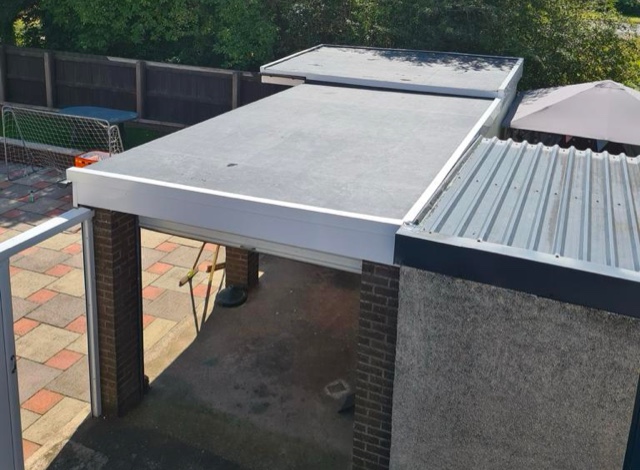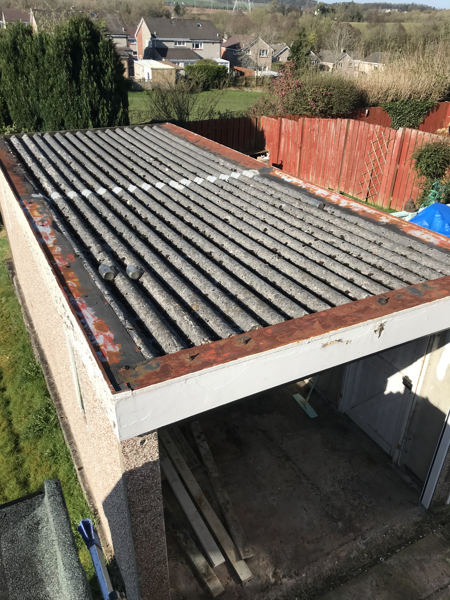Garage Roof Replacement: Replacing a garage roof is an essential task when the roof cannot be repaired due to weather damage, wear and tear, or aging materials.
Whether it’s leaks, sunken areas, or insulation issues, a proper garage roof replacement ensures your property is protected and its value is maintained.
In this guide, we’ll walk you through the key aspects of garage roof replacement, from material selection to the installation process, ensuring you get a long-lasting and cost-effective solution.

5 Signs Your Garage Roof Needs Replacement
The first step in deciding whether to replace your garage roof is to identify signs of wear and failure. Here are some common indicators:
- Water Leaks – Dampness, puddles or water stains on your garage roof indicate problems with your roof.
- Loose – A roof that sags in sections suggests a structural failure.
- Missing or Damaged Shingles – Broken, curled or missing shingles are a sign that your roofing material has aged.
- Mold Growth – Persistent mold or mildew in your garage is often due to water infiltration.
- Increased Energy Bills – Poor insulation can lead to higher heating and cooling costs, indicating the need for a new roof.
Read Also: Signs You Need Pest Control In Your Home Immediately
Selecting the Right Roofing Material for Your Garage
Choosing the right material is crucial to both the longevity and functionality of your garage roof. Here’s an overview of the most popular roofing options:
1. Asphalt Shingles
Asphalt shingles are one of the most common and affordable options for replacing a garage roof. They offer good durability and weather resistance, making them suitable for a variety of climates.
Lifespan: 15 to 30 years
Cost: Inexpensive
Pros: Easy to install, readily available, low-cost
Cons: Shorter lifespan than premium materials
2. Metal Roofs
Metal roofs offer superior durability and are ideal for garages that are exposed to heavy rain or snowfall. They also reflect heat, which contributes to energy efficiency.
Lifespan: 40-70 years
Cost: Higher up front, but low over lifetime
Pros: Extremely durable, rust, fire, and pest resistant
Cons: Higher initial installation cost
3. Rubber Roofing (EPDM)
Rubber roofing is a popular choice for flat or low-slope garage roofs. It is highly resistant to weather and UV damage.
Lifespan: 20-30 years
Cost: Moderate
Pros: Easy to install, lightweight, flexible
Cons: Not as aesthetically appealing as other materials
4. Clay Tiles
Clay roof tiles offer a distinctive aesthetic appeal, especially for homes with Mediterranean or Southwestern architecture. However, they require a sturdy roof structure due to their weight.
Lifespan: 50-100 years
Cost: Expensive
Advantages: Durable, fire- and rot-resistant
Disadvantages: Heavy and expensive

Things To Do Before Garage Roof Replacement
Before you begin roof replacement, there are several preparatory steps to take to ensure a smooth process.
1. Remove the Old Roof
The first step in replacing your roof is to remove the existing roofing material. Depending on the material, this can be a labor-intensive process. Always make sure to properly dispose of old materials in accordance with local regulations.
2. Inspect and Repair the Roof Deck
Once the old roofing material has been removed, inspect the roof deck for any signs of damage, such as rot or mold. Any damaged sections should be replaced before installing the new roofing material.
3. Install the Underlayment
A underlayment is essential to protect your garage from water infiltration. The type of underlayment will depend on the roofing material chosen, but the most common options include synthetic or asphalt felt.
Read Also: 24 Hour Emergency Plumber Near Me | Find Best 24/7 Plumber
How Much Does A Garage Roof Installation Cost?
The cost of installing a garage roof can vary widely depending on several factors, including the size and complexity of the garage, the materials used, and your location. Here’s a general breakdown:
Basic one-car garage: Typically ranges from $1,500 to $3,800.
Two-car garage: Typically costs $2,000 to $6,000, or more.
Materials: Asphalt shingles are the most affordable option, while metal roofs tend to be more expensive but offer greater durability.
Labor costs: Can vary significantly depending on your location and the complexity of the installation.

DIY Garage Roof Replacement vs. Professional Installation
While replacing your roof yourself may seem cost-effective, it is a labor-intensive and potentially dangerous task that requires specialized tools and expertise.
For smaller garages and simple roofing materials, it is possible to complete the job on your own with proper guidance.
However, for larger garages or complex roofing materials, such as metal or clay tiles, it is highly recommended to hire a professional to ensure the job is done safely and correctly.
Conclusion
Replacing your garage roof is an investment that pays for itself in the long run. By following these steps and tips, you can ensure a successful and efficient roof replacement.
Whether you choose to tackle the project yourself or hire a professional, a new garage roof will give you peace of mind and protection for years to come. 🛠️🏠
